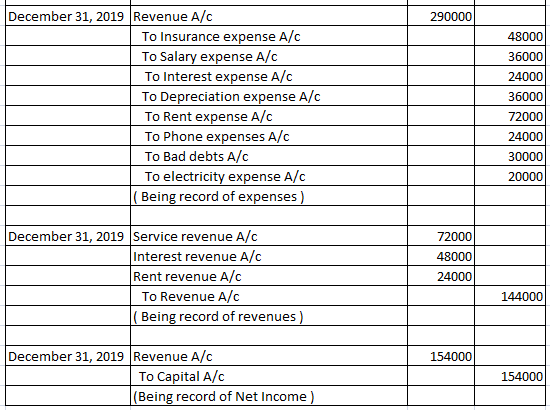Question 3: The following balances were taken from Al Buraimi Company as at 31.12.2019 Name of accounts Balances Capital ...... Creditors 60 000 Overdraft 40 000 Loans 150 000 Notes Payable 50 000 Cash 60 000 Bank 200 000 Debtors 100 000 Marketable securities 120 000 Land 140 000 Buildings 240 000 Cars 140 000 Machines 180 000 Furniture 20 000 Insurance Expenses 40 000 Salaries Expenses 40 000 Rent Expenses 60 000 Interest Expenses 30 000 Phone Expenses 20 000 Electricity Expenses 24 000 Bad Debts 30 000 Depreciation Expenses 36 000 Services Revenues 60 000 Interest Revenues 60 000 Rent Revenues 40 000 Opening Stock 90 000 Purchases 360 000 Sales Returns 70 000 Sales 670 000 Purchases Returns 70 000 Required: Prepare Closing Entries. Prepare Balance Sheet. At the end of accounting period found that Closing stockO 80 000 Insurance Expenses4000/ Month Salaries Expenses 3 000/Month Rent Expenses 6 000/Month Interest Expenses2 000/Month Phone Expenses4 000 not paid yet Electricity Expenses4 000 paid in advance Services Revenues 6 000/ Interest Revenues4 000/ Rent Revenues2 000/
Reporting Cash Flows
Reporting of cash flows means a statement of cash flow which is a financial statement. A cash flow statement is prepared by gathering all the data regarding inflows and outflows of a company. The cash flow statement includes cash inflows and outflows from various activities such as operating, financing, and investment. Reporting this statement is important because it is the main financial statement of the company.
Balance Sheet
A balance sheet is an integral part of the set of financial statements of an organization that reports the assets, liabilities, equity (shareholding) capital, other short and long-term debts, along with other related items. A balance sheet is one of the most critical measures of the financial performance and position of the company, and as the name suggests, the statement must balance the assets against the liabilities and equity. The assets are what the company owns, and the liabilities represent what the company owes. Equity represents the amount invested in the business, either by the promoters of the company or by external shareholders. The total assets must match total liabilities plus equity.
Financial Statements
Financial statements are written records of an organization which provide a true and real picture of business activities. It shows the financial position and the operating performance of the company. It is prepared at the end of every financial cycle. It includes three main components that are balance sheet, income statement and cash flow statement.
Owner's Capital
Before we begin to understand what Owner’s capital is and what Equity financing is to an organization, it is important to understand some basic accounting terminologies. A double-entry bookkeeping system Normal account balances are those which are expected to have either a debit balance or a credit balance, depending on the nature of the account. An asset account will have a debit balance as normal balance because an asset is a debit account. Similarly, a liability account will have the normal balance as a credit balance because it is amount owed, representing a credit account. Equity is also said to have a credit balance as its normal balance. However, sometimes the normal balances may be reversed, often due to incorrect journal or posting entries or other accounting/ clerical errors.
Question 3: The following balances were taken from Al Buraimi Company as at 31.12.2019
|
Name of accounts |
Balances |
|
Capital |
...... |
|
Creditors |
60 000 |
|
Overdraft |
40 000 |
|
Loans |
150 000 |
|
Notes Payable |
50 000 |
|
Cash |
60 000 |
|
Bank |
200 000 |
|
Debtors |
100 000 |
|
Marketable securities |
120 000 |
|
Land |
140 000 |
|
Buildings |
240 000 |
|
Cars |
140 000 |
|
Machines |
180 000 |
|
Furniture |
20 000 |
|
Insurance Expenses |
40 000 |
|
Salaries Expenses |
40 000 |
|
Rent Expenses |
60 000 |
|
Interest Expenses |
30 000 |
|
Phone Expenses |
20 000 |
|
Electricity Expenses |
24 000 |
|
|
30 000 |
|
Depreciation Expenses |
36 000 |
|
Services Revenues |
60 000 |
|
Interest Revenues |
60 000 |
|
Rent Revenues |
40 000 |
|
Opening Stock |
90 000 |
|
Purchases |
360 000 |
|
Sales Returns |
70 000 |
|
Sales |
670 000 |
|
Purchases Returns |
70 000 |
Required:
Prepare Closing Entries.
Prepare
At the end of accounting period found that
- Closing stockO 80 000
- Insurance Expenses4000/ Month
- Salaries Expenses 3 000/Month
- Rent Expenses 6 000/Month
- Interest Expenses2 000/Month
- Phone Expenses4 000 not paid yet
- Electricity Expenses4 000 paid in advance
- Services Revenues 6 000/
- Interest Revenues4 000/
- Rent Revenues2 000/
Journal:
Recording of a business transactions in a chronological order.
Journal entries:


Step by step
Solved in 3 steps with 4 images









